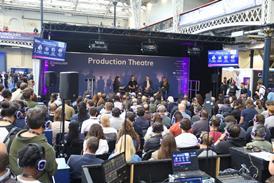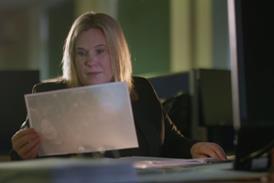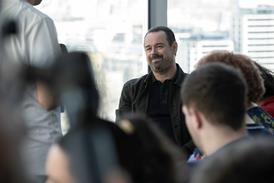This year has been one of strong competition for the UK broadcast hire market, with high returns being enjoyed at the lower end of the market, tapeless formats yet to make much impact and SD equipment still in far greater demand than high-def.
Like elsewhere in the TV industry, acquisitions have been a feature of this market. A group of former Hyperactive employees took ownership of Hire Works (previously Clear Cut Hires) six months ago, a move that has led to a trebling in monthly turnover, according to director Lawrie Read. The Farm Group took over the London-based Metro Broadcast in 2007, rebranding the hire business as Rent. Managing director Danny Whybrow feels this has provided the company with a new momentum: “2007 has seen Rent provide the equipment for a number of full location post facilities for broadcast projects, in conjunction with the group’s location specialist Man From Uncle.”
From talking to a cross-section of the market, we found that 2007 was a year of sustained growth for hire companies, but also saw diversification into related areas.
Rogue Element Films expanded into digital film-making and moved its operation into much larger premises at Pinewood Studios. “Our investment has been huge, but in our sector the returns have been very good and we see this continuing,” says managing director Dan Mulligan.
Pro Vision Technical also enjoyed sustained growth, opening an additional Manchester office and investing in a tapeless workflow trial. However, manager Danny Howarth feels that the hire sector is feeling the impact of a lack of training and basic knowledge. “Not just with the introduction of tapeless formats,” he says. “Also the basic skills of film and television are not being passed on as people move through the industry quicker and quicker, leaving large knowledge gaps.”
“In general 2007 was a good year but, as always, could have been better,” says Will Wilkinson, production director of the Cruet Company. “Two-thirds [of the year] was very busy and one-third less busy but, on the whole, it was an improvement on 2006.”
“The hire market is still alive and well,” agrees Oliver Hickey, director of DVCam specialist Kitroom Monkey. “Rates have stayed firmly in the same place and if anything are likely to go down to attract bargain hirers. The growth is sadly in the lower end kit.” However, Hickey does concede that his company is experiencing a strong return from this end of the market.
A successful year for Hammerhead TV Facilities included winning the Holby City contract, with other major deals secured throughout the year. “We have a new purpose-built facility in Manchester and made significant investment in technology,” says marketing executive Andrew Black. He reinforces the general view that broadcast hire is a fiercely competitive market.“You can’t rely on anything when quoting for business - there are now so many factors that have to be accounted for. We have seen well-established companies go to the wall over the past few years - VFG, the Picture Canning Company and OpTex - but many more hire companies [including Picture Canning North] have survived. It is a very different playing field to five or 10 years ago.”
Shaun Wilton, assistant facilities manager at Shooting Partners Facilities, says that crew rates are on the rise. “We have crewed up a number of shows over the last year with healthy rates,” he explains. “There is also a consistency in standard definition hires. We have continued to do well from DigiBeta and DVCam hires and in fact the number of hires in the last year has risen.”
‘Oversaturated’ marketplace
However, Wilton feels that the hire market is actually oversaturated. “Rates have suffered on kit for years for a number of reasons,” he says. “Certain hire companies offered HD for DigiBeta prices, which didn’t help the emerging HD market. Others don’t quote on a like-for-like basis. Potential customers get used to paying rock bottom prices and some don’t care what quality of kit they receive in return.”
“Some companies have resorted to reducing prices to unprecedented levels to shift idle kit,” agrees Rent’s Whybrow. “This means the market becomes increasingly driven by price and not value, reducing returns and making investment decisions increasingly difficult. Market rates for new equipment are reducing within a shorter timescale than has traditionally been the norm.”
“It’s a crowded market at the moment but we consider it to be a healthy one,” says Duncan Martin, director of dry hire company Pro Motion. “Rates could be better, but production budgets seem to have remained static or have even been cut, whereas the cost of equipment has not got any cheaper.”
However Clive Northen, UK rental manager for Gearhouse Broadcast, claims that through prudent timing and choice of investment, specifically in HD equipment, his company has actually taken market share from its competitors. “Outside broadcasts have been fantastic; our sporting calendar has been choc-a-bloc with the likes of the Premiership football and the Rugby World Cup, which was massive and used a large amount of HD kit,” he says. “Studio work has seen a healthy growth this year on the back of regulars such as The X Factor and Test the Nation, and we have also hired to a number of new shows and studios.”
Axis Films has also seen an increase in its market share in 2007. “The hire market is relatively buoyant,” says managing director Paul Carter, though he adds that smaller margins and a significant increase in the range of cameras and HD formats has made rentals a tougher market. “While turnover continues to grow, the market demands an increasingly broad inventory that covers new and developing formats,” he says. “At the same time there is also a demand for greater specialisation. We have realised that the company’s continuing success will be greatly enhanced by offering a ‘suite of services’ to potential clients.” Other companies have diversified too. Ranald Neilson, broadcast services manager of Metro Ecosse, has overseen the growth and development of the facility element of the company. “A lot of our facility work has been fed by Metro’s own VT and online media productions,” he says. “I think we have finally seen an increase in productions specifically intended for internet broadcast. Metro Ecosse is also a keen partner of arts projects in Scotland, providing facilities for among others, the Celtic Film and TV Festival and our own short film competition One Minute Wonder.”
“This year has been very successful for us,” adds Kitroom Monkey’s Oliver Hickey. “We have doubled staff and floor space. Turnover is up and we are forging into new territories. Our main development this year is our teaching arm. We have undertaken more courses - both one to one and class - than any other year.”
Post-production hire too is healthy. “We’ve had a very successful year with a growing inventory of technology and an expanding list of clients,” says Hiring Post managing director David Johnson. “We anticipate more expansion in 2008.”
“Returns on the hire of post-production equipment are holding up very well but remain competitive,” says Lawrie Read. “Approximately half of 1% of the purchase price as a daily rate is the current return on equipment investment. However the past year has seen many more facilities houses buying and installing their own editing equipment. As a consequence, they now have less rooms for dry hire, and therefore they have become reluctant to let rooms out for offline editing unless it’s with their own kit.”
High definition
There is some debate on what effect high-definition equipment is having on the hire market. “I think that HD, rather than kickstarting new business has stalled it temporarily,” says Ranald Neilson. “My impression is that producers are in a state of flux as to which direction to take. Services companies like ourselves simply can’t afford to get the next investment wrong.”
“Unlike the USA there is no legal requirement in the UK to broadcast in HD and no current plans to make this the case,” says Lawrie Read. “Also the costs of jumping to HD can still put production companies off. The availability of widescreen SD equipment and the high quality of SD output are other factors that are slowing down the transition.”
Cal Barton, managing director of ProCam, agrees that take-up of HD has been slower than many predicted. “However, it is happening,” he says. “This year we purchased several XDCAM HD camcorders, the Sony HDW-900R, the Panasonic HDX900, more Sony HDW-750Ps and we continue to see some demand for Varicams and the HVX200.”
Gearhouse Broadcast still services a huge demand for standard-definition production, but has made significant investments in HD kit this year including large orders for lenses, VTRs, cameras and EVS equipment. Not surprisingly Northen disagrees with the view the HD market is slow: “We have been heavily involved in HD live events this year - it has been our core business activity,” he explains. “HD studio business has been lively and I believe this is only set to increase in 2008.However, HD kit, such as cameras, is going to be used in an SD environment while we wait for more and more productions to move over to HD. This is to be expected and factored into any purchase.”
“We’ve seen demand for HD increase phenomenally during this year in both hire and post, notably without SD demand reducing,” says Danny Whybrow. “All of our HD investments have proven profitable, to the extent that we’re currently looking to make further investment in HD equipment to expand our hire fleet.”
Rogue Element Films has also been active in HD hire. “Our investment has been extreme but the return on investment has been terrific,” says Dan Mulligan. “We have no shortfall due to the market we cater for.”
Shooting Partners was an early adopter of HD. “We’ve been investing in HD lenses for quite some time and have a large amount of ‘future proofed’ stock as a result,” says Shaun Wilton. “Our main areas of development during 2007 have been a significant increase in HD VTR hires, plus HD single camera set-ups utilising our stock of Canon HD lenses.”
Wilton says that it’s essential to be in it for the long haul to make good on this investment, but has no doubt that HD is the future: “Many content producers have been reluctant to make changes to their budgets to accommodate our expensive HD purchases, but we have had a major involvement in supplementing Sky Television’s ever-expanding high definition sports coverage, including Premier League football and rugby.”
“Everyone is up for HD acquisition but the money isn’t always there to justify it,” says Duncan Martin. “The knock-on effect is that we have to be flexible with our rates on HD hires. We have invested a lot in HD this year but it is the future and we are confident about the future.”
The coming year
Looking ahead, the Cruet Company’s Will Wilkinson believes the SD formats of Digi Beta and DVCAM will continue to provide a solid base for hire, but that HD will become more prolific as broadcasters make the switch. “Broadcasters such as Sky which are delivering day-to-day programmes in HD will ensure that the increased demand for HD filters through to the hire and post industries,” he explains.
Cal Barton also expects increased demand for HD in 2008. “We are watching the introduction of Sony’s 2/3-inch XDCAM HD camcorder and to see if Panasonic’s HPX3000, which has a native 1080-line block, generates much interest.”
Axis Films has seen a growth in interest in mini HD cameras and is to move into 3D soon. “This has been prompted by the 3D upgrade of our Quantel iQ - the first such upgrade in Europe,” says Carter. “I believe 2008 will see a shakedown in the rental market in terms of mergers and acquisitions and even closures.”
Lawrie Read also foresees some consolidation and believes competition will be even greater next year. “The movement of data will gather speed, literally as well as actually,” he says. “The concept of pipeline post between locations will start to become the norm instead of the exception.”




























No comments yet